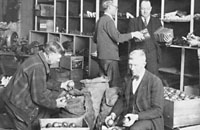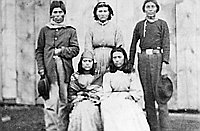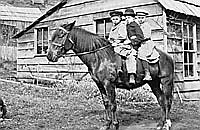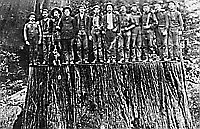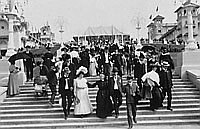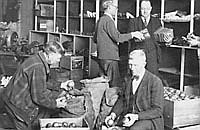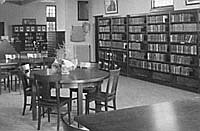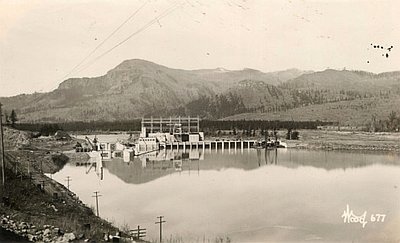Along with the rest of the nation, Oregon fell on hard times during the 1930s. Bank failures, bankruptcies, business foreclosures, and high unemployment worsened conditions in the region’s struggling agricultural and lumber sectors. The Oregon and Washington economies had floundered following World War I because of defunct shipyards, glutted markets for agricultural goods, and weakness in the construction industry. Oregon’s lumber industry depended on California markets for much of its livelihood, and it suffered greatly when prices and demand in the Golden State continued to decline.
The region’s major trade organization, the West Coast Lumbermen’s Association, announced in August 1931 that its mills were operating at only 38 percent of capacity. Delinquent county and local taxes meant financial collapse, businesses could not meet their payrolls, and there was not enough money to fund community services. The needs of Oregonians quickly overwhelmed private relief efforts, job clearinghouses, donations of food and clothing, and meal tickets for the destitute. Ultimately, voluntary assistance did little to lessen the poverty and hunger that settled over Oregon and the Pacific Northwest. To compound those difficulties, the arrival of migrants from the Northern Plains states and the South added to the number of the unemployed.
In the Portland metropolitan area, where construction activity had slowed sharply after 1925, depressed lumber prices forced many sawmills to close down well before the October 1929 stock-market crash. Because of high unemployment and the increased number of destitute people in the city, local officials had exhausted all local emergency funds by mid 1930. By the time Franklin Roosevelt was inaugurated as president in March 1933, 40,000 people in Oregon were on relief and 24,000 householders were registered with the Portland employment bureau. Public and private agencies, like the Public Welfare Bureau, the Salvation Army, and the Red Cross, as well as state and local governments assisted in providing most of the relief to Oregonians until early 1932, when Oregon increasingly relied on federal relief programs. [MY1]
The collapsing economy worsened conditions in Portland’s poorer neighborhoods, and camps of unemployed people, known as Hoovervilles, appeared in the city. One hundred people lived under the west end of the Ross Island Bridge, more than 300 bivouacked in Sullivan’s Gulch on the near east side, and a large group of homeless congregated at the former site of the Lewis and Clark Exposition, the filled-in Guild’s Lake on the west side. In the summer of 1932, fearful of social disruption, Governor Julius Meier, who had been elected as an independent, wrote President Herbert Hoover for assistance: “We must have help from the federal government if we are to avert suffering and possible uprisings.”
Although Portland participated in several New Deal programs, the city’s political leaders were not enthusiastic about most federal initiatives. Shortly after his election in 1932, Mayor Joseph Carson told local business groups that his administration would not look for federal handouts. Throughout his tenure in office—from 1932 to 1941—Carson strongly opposed all public power proposals, and he gave his wholehearted support to waterfront employers during the Portland dock strike of 1934. With the support of a majority of the city council, he successfully fought local efforts to establish a city housing authority in 1938, arguing that public housing would depress property values and was akin to “unadulterated Communism.” Carson’s language became even more inflammatory in opposing Roosevelt’s WPA initiative in 1935, the New Deal’s best-known work-relief program.
Beyond Portland’s conservative political establishment, New Deal programs were immensely popular. The CCC, perhaps the most celebrated of the reform initiatives, operated camps across the state, providing modest wages, food and shelter, and constructive outdoor work for young men. Before it was disbanded in 1942, the CCC had employed more than three million “boys” nationwide, with nearly 87,000 thousands of men in Oregon “boys” who were housed, military style, in forty-nine camps across the state. The young men labored at forestry and conservation jobs, building roads, trails, shelters, and lookouts, and were part of a vastly expanded work force for fighting forest fires.
The Coos Bay Times gave the CCC unstinting praise on its fifth anniversary in 1938: “The CCC experiment has been so much of a success that it is being continued. Anything that prevents soil erosion, builds new forest highways, opens new park projects, sets out new trees, saves the old ones from fire—anything that does such things is of lasting value to the country.”
CCC labor was responsible for constructing dozens of public parks in Oregon, including Silver Falls State Park east of Salem and the Jessie M. Honeyman State Park on the central coast. CCC and WPA workers also helped build Timberline Lodge, high on the southern slopes of Mt. Hood, and the Oregon Department of Forestry headquarters in Salem. Other visible reminders of New Deal work programs include murals in post offices and public buildings across the state.
During the late 1930s, the Oregon highway department used state and federal monies to put people to work building bridges over the bays and estuaries on the Oregon Coast. The graceful bridges were designed by Conde McCullough, who headed the Bridge Division of the Oregon Department of Transportation from 1920 to 1935. When the 1,700-foot cantilever bridge across Coos Bay was completed in 1936, it was the longest in the Pacific Northwest. The bridge's vaulting height permitted ocean-going vessels to pass underneath, and the engineering blueprint for the bridge involved complex planning and design work. The completion of the coastal bridge network quickened travel along Oregon Highway 101 and eliminated the inefficient ferry systems on the numerous streams and estuaries.
When the Roosevelt Administration used the Emergency Relief Appropriations Act of 1935 to establish the WPA, it introduced the largest and one of the more controversial of the New Deal initiatives. Until World War II, the WPA was the most visible of federal relief agencies in the United States, employing more than 3 million people in its first year and a total of 8.5 million before the agency was closed in 1942.
In Portland, the WPA put 25,000 people on the federal payroll to work on projects that included building Rocky Butte Scenic Drive and the Portland Municipal Airport. To maximize its potential for direct relief, the agency shied away from using mechanized equipment, and WPA workers relied on hand tools to do most of their work. The Portland airport project, which regularly employed more than a thousand people, was the most significant WPA activity in Multnomah County, but it was the less glamorous, smaller projects that put the greatest number of people to work. The hundreds of small-scale projects in the city included constructing and improving local parks, building roads, installing street drainage systems, and clearing brush and building an extensive trail system at Macleay Park in the West Hills.
The WPA also hired Oregonians to build the Wolf Creek and Wilson River Highways, an undertaking that speeded travel to the coast. The agency used an old CCC camp on the Wolf Creek section to house workers. The WPA also hired skilled Portland-area artisans to produce ornamental wrought iron for projects across the state, including Timberline Lodge on Mt. Hood. The agency supported Portland musicians who performed in public places around the city, at the Portland Art Museum, and at Marylhurst and Reed Colleges. The WPA’s Federal Arts’ Theater and Writers’ projects attracted attention and controversy because conservatives considered such programs frivolous. The Writers’ Project produced the Oregon Guide, a descriptive narrative of the state's history, physical landscape, and cultural heritage.
Although the WPA included women in its service-project jobs, females made up only a small percentage of the agency’s workforce. Federal, state, and local administrators assumed that useful and productive work primarily involved construction jobs, traditionally the province of males. While Eleanor Roosevelt and a few others spoke out on behalf of WPA employment for women, “institutionalized sexism in the WPA guidelines,” writer Neil Barker argues, “made most women ineligible for work relief.” The few women able to obtain such work were placed in sewing-related or housekeeping jobs, or they served school lunches to needy children. Portland-area women also found WPA jobs through the household service-training program, a closely supervised plan that provided domestic labor for the city’s elite.
In Portland and Oregon’s other cities, people survived the Depression years by having fewer children, living in multiple-family households, and taking sporadic and part-time jobs. In rural areas, barter, labor exchanges, and the time-honored practice of poaching usually meant that people had enough food on the table. Family members frequently exchanged labor on neighboring farms and ranches for fruits, vegetables, and dairy products. Wood for cooking and heating was easily accessible, and wild fruits, especially blackberries, were seasonally abundant and easy to preserve. In coastal communities, the ocean troll-fishery thrived, although the returns on the daily catch were usually at the mercy of a very weak market. One woman later remembered that, although food was plentiful, neither their neighbors nor her family had “new clothes to speak of for several years.”
The Great Depression remained a fact of life for a full decade and began to ease only when investments in war preparation slowly began to boost the American economy in late 1940 and 1941. Despite improved conditions in the late 1930s, the WPA continued to provide employment for a large number of workers in Oregon’s more heavily populated counties. Although the pay was low, federally subsidized work enabled citizens to earn a modest income at a time when job prospects were few. Throughout the 1930s the number of people receiving some form of direct relief remained high; those classes of welfare included support for dependent children and seniors, surplus food, and a category referred to as “general assistance.”
Despite the variety of New Deal work-relief programs, the economy moved unevenly through partial recoveries and slumps for the remainder of the decade. In early 1940, the Coos Bay Times reported that the southwestern Oregon economy continued to struggle: “This area suffers, as does much of the United States, from almost chronic unemployment of some needy citizens. Youth particularly is finding it hard to gain steady employment. Relief loads are heavy but by the combined efforts of federal, state and county governments, are being met.”
Historian Carl Abbott describes Portland at the end of the Depression decade as “a city that had ceased to grow.” At the close of the 1930s, the city had fewer skilled and more unskilled workers and domestic laborers than it did in the 1920s. Portland had also grown older during the decade, a trait reflected in the declining number of school-age children by 1940—23 percent of the city’s population compared to 35 percent nationally. Those population characteristics were temporary, however. The wars in Europe and Asia brought an end to years of unemployment and stagnation, and workers accustomed to long periods of unemployment suddenly found themselves sellers in a buyers’ market.
© William G. Robbins, 2002. Updated and revised by OE Staff, 2014.
[MY1]Mullins, The Depression and the Urban West Coast, 1929-1933, 41, 83, 85
